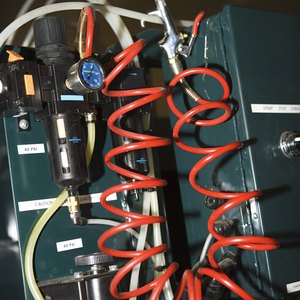
Asset turnover ratios help analysts and investors view the relationship between a company's assets and sales revenue. Reviewing asset turnover ratios may help identify sluggish inventory issues or check in on a company's sales growth and corresponding use of assets. The ratio of total asset turnover considers how the company drives sales through the effective use of its assets.
Total Asset Turnover (TAT) Ratio
The total asset turnover, or TAT, ratio measures how well a company utilizes all of its current and fixed assets to generate revenue for the company. An accountant or analyst calculates the ratio starting with net sales and dividing by total assets. The resulting figure shows the number of times the company's sales cover its assets. For example, a firm has $20 in sales and $10 in assets. The ratio result, $20 divided by $10, is stated as "two times," meaning sales covers the value of assets twice.
Total Assets
A firm's total assets show on the top section of its balance sheet. Total assets consist of two parts. Current assets are those used up by the firm within one year. These easily liquidated assets consist of cash, accounts receivable, inventory and short-term investments such as certificates of deposit. The second category, long-term, or fixed, assets consists of items such as buildings, land, machinery, equipment and tools.
Interpretation
Analysts can derive meaningful information from the TAT ratio when comparing it against the same ratio for prior periods in the subject company's financial history. If the result, the number of times sales covers assets, is higher -- the company has improved efficiency and produced more sales per asset. If the ratio is lower, the firm might be experiencing lower sales for a variety of internal or external reasons. Inventory might consist of outdated, less-desirable products. Creditors might be taking longer than usual to pay, keeping the firm's accounts receivable balance too high. The firm might also be under-utilizing its buildings and machinery, leading to a lower TAT ratio.
Considerations
When using the TAT ratio to evaluate a firm's financial performance, the analyst should look at the same ratio at different points in the firm's history. Using the average total assets and net sales over time can help smooth out fluctuations. Additionally, the firm's TAT ratio should be compared against the performance of its industry group and close competitors for relevance. Some industries require significantly more assets to produce sales, and a ratio result of 0.5 times might be normal for a manufacturing company, yet it could be too low for a service business that creates sales without the need for many fixed assets.
References
- AccountingCoach; What is the Total Asset Turnover Ratio?; Harold Averkamp
- Walmart. "2017 Annual Report," Pages 36 and 38. Accessed Sept. 11, 2020.
- Target. "2016 Annual Report," Pages 34 and 58. Accessed Sept. 11, 2020.
- AT&T Inc. "2016 Annual Report," Pages 10 and 47. Accessed Sept. 11, 2020.
- Verizon. "Building a Connected World -- Annual Report 2016," Pages 40 and 42. Accessed Sept. 11, 2020.
Writer Bio
Cynthia Gaffney has spent over 20 years in finance with experience in valuation, corporate financial planning, mergers & acquisitions consulting and small business ownership. She has worked as a financial writer for online finance publications since 2011, including eHow Money, The Motley Fool, and Sapling.com. She has also edited for several online finance publications, including The Balance, Opposing Views:Money, Synonym:Money, and Zacks.com. A Southern California native, Cynthia received her Bachelor of Science degree in finance and business economics from USC.
